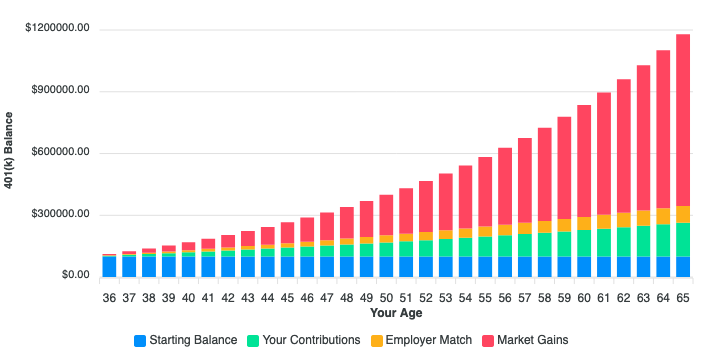On this page is a 401(k) calculator, also useful for modeling a 403(b).
Enter details of your current balance, age, salary, and retirement plan plus your employer's details, and the tool will model (or graph) your future savings.
401(k) or 403(b) Planning Calculator
Using the 401(k) Calculator
A 401(k) plan (or a 403(b) plan for non-profits) is one of the most popular perks employers offer. It is named after a provision in the US tax code – yes, even in other countries that name their plan "a 401(k)".
In a traditional plan, you contribute tax-free dollars today to pay taxes on the back-end – a fantastic perk if you plan to withdraw less income in retirement. Many employers also offer a Roth version, where the Government promises never to tax you again on the money you contribute today – after paying the appropriate tax.
Also, in many cases, your employer might contribute a match. If you put up a certain amount from your paycheck, your employer might sweeten the pot by contributing a proportionate amount.
Planning Tool Inputs
Deferred plans have many complications. To use the 401(k) tool, you'll have to gather some data about your plan:
Current 401(k) Plan Inputs
- Current 401(k) Balance: If you currently have some money in your 401(k) or 403(b), enter the amount here.
- Annual Salary: The amount you make a year.
- Percentage Contribution: What percentage of your salary will you contribute to the plan.
- Current Age: Your age today.
- Retirement Age: The age when you plan to retire.
- Employer Match: What percentage of your whole dollar salary will your employer match? (For many companies, this is 25%, 50%, 100%, or 200% on the dollar you contribute).
- Up to What % of Salary?: What is the maximum salary percentage where the plan applies?
Market and Raise Assumptions
All projections are wrong – but some are useful.
Unfortunately, you'll need to do some prognosticating here. We'll need a guess at how your salary will evolve, as well as an investment of how your investments will perform.
- Investment Return Annually: Enter the percentage your 401(k) or 403(b) investment will return every year. You might use a number from the S&P 500 Historical Return Calculator or the Treasury Return Calculator.
- Yearly Raise: There are lean years, and there are flush years – over your career, what percentage raise will you average annually? You might check our income by age research or calculator.
Tool Outputs
You can either see summary statistics modeling your 401(k) or 403(b) or increase the resolution and graph your projections.
Simple 401(k) Calculation
To see the summary, click the blue 'Project 401(k) Balance' button. You'll then see the total amount, plus a breakdown of the funding sources.
- Balance at Retirement: Our best estimate of the total balance in your 401(k) when you retire.
- Starting Balance: The amount of money you started the projection using (you told us right above).
- Your Contribution: Total contribution over the remainder of your career.
- Employer Contribution: Match contribution for the remaining years in your career.
- Market Gains: Our best guess at market gains over the remaining years in your career.
Advanced Calculation
While the summary statistics are fun, sometimes you really just need to see a 401(k) balance visualization.
If you hit the orange 'Project & Draw Graph' button, you'll get all the information from the simple calculation plus a graph which shows the annual change. If you hover (click/tap on mobile), you can see the 'total' balance at the end of each year, plus how the buckets have evolved to that point.

If you click the upper right 'hamburger' menu, you can export the graph's projection data. Choose svg or png for a graphical export, or use the csv option to model in your favorite spreadsheet program.
401(k) Calculator Methodology
Necessarily, I had to make a few simplifications in the tool – it's impossible to see the future, as you know.
I've already mentioned that you need to add your projections for your income, plus stock returns. Additionally, the tool will compound returns monthly, assuming that stock has a smooth and clean return (it never does!). The tool currently doesn't 'cap' input; it can model contributions larger than the 401(k) contribution limit.
Finally, the tool assumes a whole 'age,' with you retiring at the end of your Retirement Age. If you select a retirement age of 65, the tool assumes you receive 12 months' worth of paychecks as a 65-year-old. Also note, the average retirement age in the US is a bit lower than 65.
401(k)s and 403(b)s: Popular Company Benefits
401(k)s and 403(b)s are popular for a reason. They let you adapt your retirement strategy to changing tax regimes – by giving up liquidity, you gain substantial planning benefits long term.
See some other useful tools which will help your planning:
